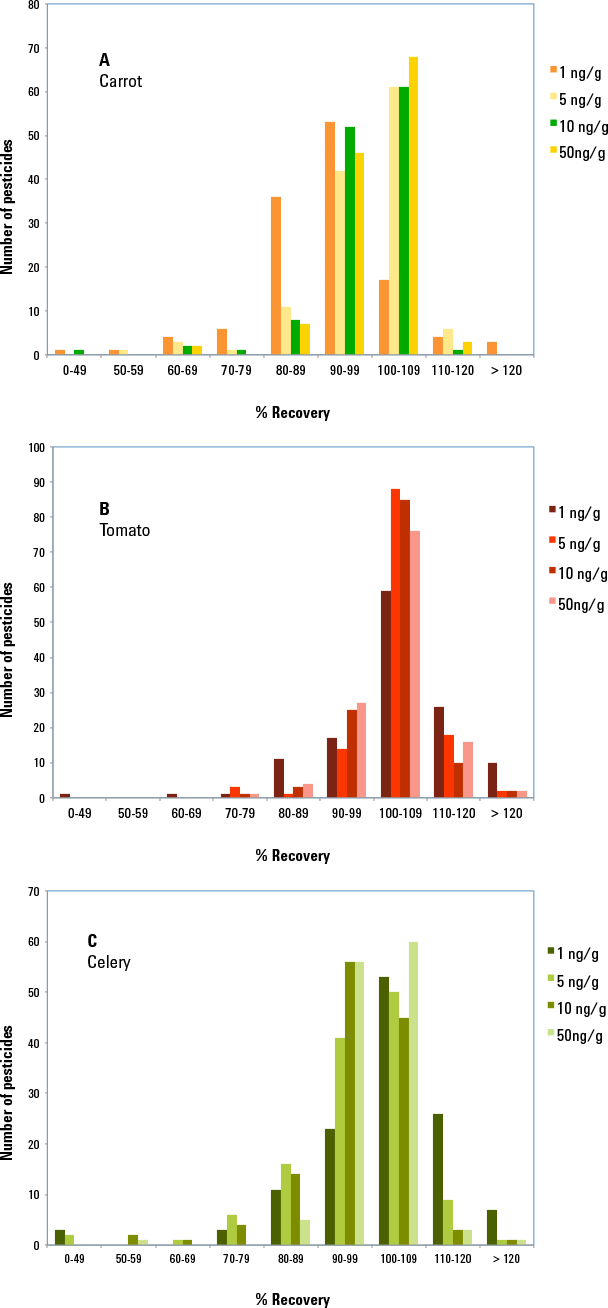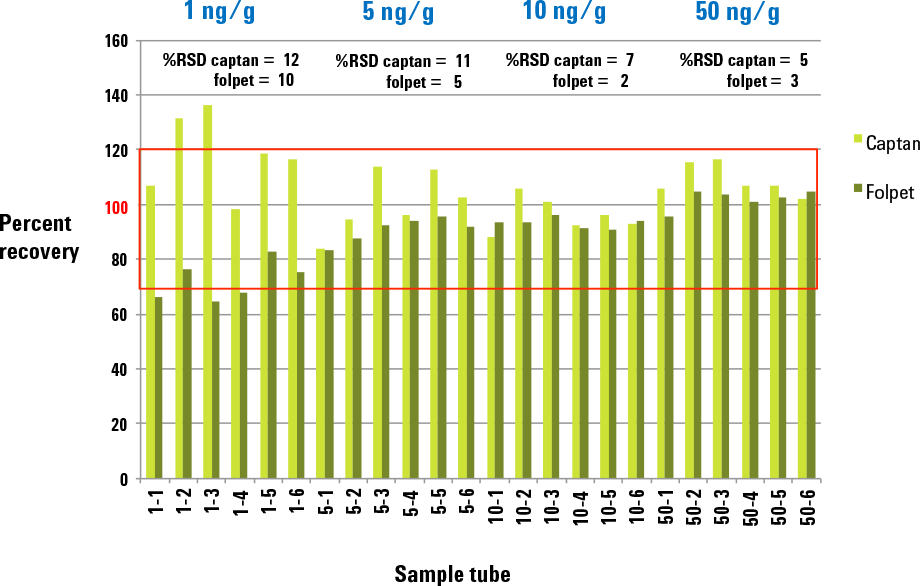Access Agilent eNewsletter October 2015
>> Update My Profile | Subscribe to Access Agilent | Article Directory
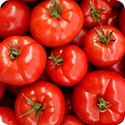
Reduce cost of pesticide residue analysis with Agilent Mini-QuEChERS and GC/MS/MS with a high-efficiency source
By Melissa Churley and Joan Stevens
Agilent Senior Applications Scientists
Improved sample preparation for reliable analysis of pesticides is a priority for food safety. The QuEChERS (Quick, Easy, Cheap, Effective, Rugged, and Safe) sample preparation method is widely used for food analysis, but many labs experience cost pressures and would like a less expensive version of this popular technique. To reduce cost, Agilent has developed a miniaturized sample preparation version of QuEChERS. Because smaller samples require additional GC/MS/MS sensitivity, Agilent combined the high-efficiency source of the Agilent 7010 Series Triple Quadrupole GC/MS – which reduces sample injection by 75% – with Agilent miniaturized QuEChERS for optimized sample preparation and improved analysis of pesticides in food.
Miniaturizing sample preparation has several advantages:
- Less solvent use means reduced solvent cost and waste.
- Smaller sample sizes are easier to handle, store, and process in the lab.
- Sample preparation sorbent and labeled compounds used as internal standards cost less.
- Smaller sample sizes allow you to use additional labeled compounds for troublesome analytes – compounds that are cost-prohibitive with larger sample sizes.
Reduce extraction costs by more than 40%
In our example, we used Mini-QuEChERS for the extraction of pesticides and achieved cost savings of more than 40% due to reductions in solvent, sorbent, and labeled internal standards (ISTDs).
The Agilent high efficiency source required only a 0.5 µL injection, which further reduced sample cost through decreased maintenance while still enabling lower limits of quantitation (LOQs). In carrot, tomato, and celery matrices, recovery-based LOQs for 86-90% of the 126 pesticides analyzed were 1 ng/g, and 95-98% of the pesticides had LOQs ≤ 5 ng/g, which is half the accepted default maximum residue limit (MRL) of 10 ng/g. We quantified the challenging captan and folpet residues at ≤5 ng/g and 1 ng/g, respectively. To do this, we employed the commercially available ISTDs captan-d6 and folpet-d4 for only $0.04 per sample.
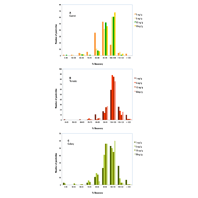 Enlarge
Enlarge
Figure 1. Distribution of average recoveries for 126 pesticides spiked at 1, 5, 10, and 50 ng/g in carrot (A), tomato (B), and celery (C).
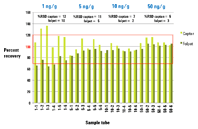 Enlarge
Enlarge
Figure 2. Individual recoveries of captan and folpet spiked at 1, 5, 10, and 50 ng/g in 2 g celery samples.
Get better results with an inert flow path
To further improve our analysis, we maximized flow path inertness by using Agilent J&W HP-5ms Ultra Inert GC columns (5 m x 0.25 mm, 0.25 µm and 15 m x 0.25 mm, 0.25 µm), Agilent Ultra Inert 2 mm dimpled liner, and Agilent UltiMetal Plus Flexible Metal ferrules at the Agilent Purged Ultimate Union used to backflush the column.
Achieve reliable quantitation
Calibration standards prepared at concentrations of 0.5, 1, 5, 10, and 50 ng/g yielded correlation coefficient (R2) values that were ≥0.992 for 97% of the 126 pesticides used to fortify the carrot, tomato, and celery matrices.
Reported LOQs were based on six replicate recovery samples for which average recovery was between 70% and 120% and percent relative standard deviations (%RSDs) were ≤ 20. Figure 1 shows the distribution of recovery percentages for the prespiked matrices. We reached LOQs of 5 ng/g or lower for 95, 98, and 97% of the 126 pesticides analyzed in carrot, tomato, and celery, respectively. We achieved an LOQ of 1 ng/g for 86% of the pesticides in carrot, 89% in tomato, and 90% in celery. Note that we performed the QuEChERS extraction/partitioning step with mechanical shaking, and this technique increased pesticide recoveries up to 35% over manual shaking.
Achieve robust analysis of problematic captan and folpet
Captan and folpet are base-sensitive compounds and are often the most difficult to recover when using QuEChERS. Miniaturization allows addition of internal standards of 100 ng each of captan-d6 and folpet-d4 to a 2 g sample at a total cost of $0.04 per tube.
Resulting LOQs for captan and folpet were 1 ng/g in celery, which is well below the MRLs of 50 ng/g for each commodity. Figure 2 shows individual recovery results for six replicate samples with %RSD at each level.
Reduce costs significantly – without sacrifice of sensitivity
As shown in Table 2, Agilent Mini-QuEChERS provides cost savings from 43 to 48% per sample, depending on the type of dispersive clean-up you choose.
Sample preparation cost/sample |
Centrifuge tube |
ACN |
Salts |
Internal standards: captan-d6, folpet-d4 |
dSPE general F&V or universal |
Total cost/sample |
Cost savings |
|---|---|---|---|---|---|---|---|
|
QuEChERS |
$0.43 |
$1.50 |
$2.96 |
$0.30 |
$1.32/$1.96 |
$6.51/$7.15 |
- |
|
Mini-QuEChERS |
$0.42 |
$0.20 |
$0.80 |
$0.04 |
$1.32/$1.96 |
$2.78/$3.42 |
43%/48% |
ACN = acetonitrile
dSPE = dispersive solid phase extraction
F&V = Fruits & Vegetables
Table 2. Cost breakdown for sample preparation with QuEChERS and Mini-QuEChERS techniques.
Save money with miniaturized method and optimized ion source
With Agilent miniaturized QuEChERS, you benefit from significant cost savings through both scaled-down sample preparation and decreased instrument maintenance. These savings are made possible by use of a miniaturized method and a high efficiency source for GC/MS/MS analysis. You can achieve low LOQs of 1 ng/g for 86-90% of pesticides spiked into carrot, tomato, and celery – despite injecting 75% less sample to improve ruggedness of the overall method.
To learn more about the use of QuEChERS for food safety, explore a free Applications Notebook. Then adopt miniaturized QuEChERS to reduce costs in your lab.
>> Update My Profile | Subscribe to Access Agilent | Article Directory
